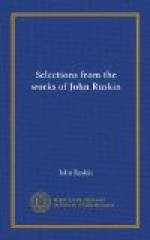In different places of my writings, and through many years of endeavour to define the laws of art, I have insisted on this Tightness in work, and on its connection with virtue of character, in so many partial ways, that the impression left on the reader’s mind—if, indeed, it was ever impressed at all—has been confused and uncertain. In beginning the series of my corrected works, I wish this principle (in my own mind the foundation of every other) to be made plain, if nothing else is: and will try, therefore, to make it so, so far as, by any effort, I can put it into unmistakable words. And, first, here is a very simple statement of it, given lately in a lecture on the Architecture of the Valley of the Somme,[199] which will be better read in this place than in its incidental connection with my account of the porches of Abbeville.
I had used, in a preceding part of the lecture, the expression, “by what faults” this Gothic architecture fell. We continually speak thus of works of art. We talk of their faults and merits, as of virtues and vices. What do we mean by talking of the faults of a picture, or the merits of a piece of stone?
The faults of a work of art are the faults of its workman, and its virtues his virtues.
Great art is the expression of the mind of a great man, and mean art, that of the want of mind of a weak man. A foolish person builds foolishly, and a wise one, sensibly; a virtuous one, beautifully; and a vicious one, basely. If stone work is well put together, it means that a thoughtful man planned it, and a careful man cut it, and an honest man cemented it. If it has too much ornament, it means that its carver was too greedy of pleasure; if too little, that he was rude, or insensitive, or stupid, and the like. So that when once you have learned how to spell these most precious of all legends,—pictures and buildings,—you may read the characters of men, and of nations, in their art, as in a mirror;—nay, as in a microscope, and magnified a hundredfold; for the character becomes passionate in the art, and intensifies itself in all its noblest or meanest delights. Nay, not only as in a microscope, but as under a scalpel, and in dissection; for a man may hide himself from you, or misrepresent himself to you, every other way; but he cannot in his work: there, be sure, you have him to the inmost. All that he likes, all that he sees,—all that he can do,—his imagination, his affections, his perseverance, his impatience, his clumsiness, cleverness, everything is there. If the work is a cobweb, you know it was made by a spider; if a honeycomb, by a bee; a worm-cast is thrown up by a worm, and a nest wreathed by a bird; and a house built by a man, worthily, if he is worthy, and ignobly, if he is ignoble.




